Physical Address
304 North Cardinal St.
Dorchester Center, MA 02124
In the presence of penetrating brain injury, the first step is to initiate advanced trauma life support resuscitation with early transportation for definitive care.
The major principles of management of penetrating brain injuries include early decompression with conservative débridement of the brain. Surgeons should avoid disrupting functional eloquent cortex when chasing deep-seated fragments. In addition, it is important to identify and remove superficial expanding hematoma and foreign material, reconstruct the skull, and attempt a watertight dural closure of the dura and scalp.
One should attempt to avoid secondary injury (ie, meningitis, seizures, delayed vasospasm, and stroke) through protocol-driven neurocritical care, which includes monitoring intracranial pressure and drainage of cerebrospinal fluid when appropriate.
It is essential to maintain a high suspicion for acute and delayed neurovascular injuries (ie, traumatic aneurysms) with subsequent endovascular diagnostic evaluation and treatment when indicated.
Delayed or immediate restoration of normal bone and soft tissue anatomy can be accomplished through craniofacial reconstruction techniques.
A 17-year-old male presents to the trauma bay after he was found down with a gunshot wound to the head. He is initially resuscitated and stabilized in the trauma bay. GCS 7 (E1, V2, M4). His initial presentation and imaging are shown in Fig. 27.1 .
What factors are important to determine if any intervention is needed?
How can we better optimize the patient medically?
What surgical principles from the military can we apply to civilian cases when intervention is warranted?
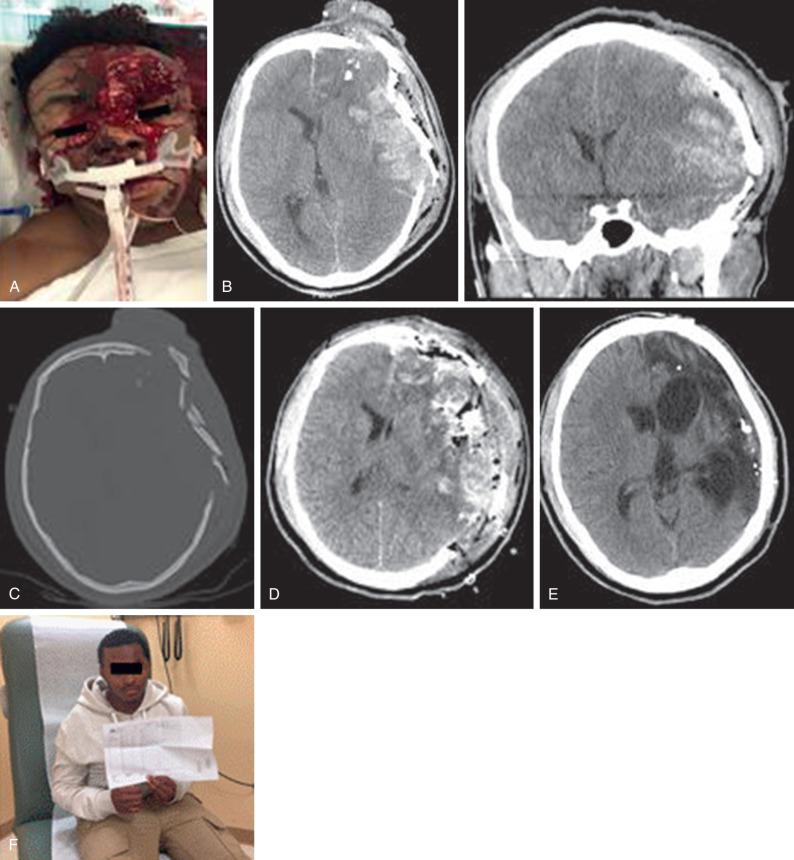
Penetrating brain injury (PBI) is often a neurosurgical emergency that presents management challenges based on differences in injury mechanism (missile, fragment, velocity), injury location, and resultant secondary damage. When faced with a severe PBI, the first concern is the survivability of the patient. Separating the fatally injured patient from those who would benefit from surgical intervention can be difficult, especially when young, previously healthy patients are affected. Good outcomes for those who survive the initial injury can depend not only on accurate and early surgical intervention but also on the ability to provide high-intensity, multimodality neurocritical care in a timely fashion.
The modern treatment of PBI developed predominantly from military experience, beginning with Dr. Harvey Cushing, and continues today with lessons learned from penetrating trauma in wartime conditions. In addition, our improved understanding of the basic science of PBI, along with improvements in critical care, has allowed us to optimize the care for these patients. Although it may be argued that the mechanism of both civilian and military PBI constitutes the same traumatic forces, we must be careful to generalize recommendations for treatment and draw distinctions between the two scenarios when appropriate. This chapter therefore provides a historical foundation for the modern treatment of penetrating brain injury and further outlines the surgical and critical care principles that are applicable today. Commentary concerning the applicability of aggressive surgical and critical care interventions garnered from military experience adapted to the civilian setting will be suggested. Tenets of patient selection, hematologic challenges, circulatory resuscitation, surgical technique, and complication avoidance are stressed.
No discussion of the neurosurgical management of penetrating brain injury is complete without first acknowledging Dr. Harvey Cushing's contributions during World War I. His landmark 1918 British Journal of Surgery article consisted of a retrospective review and classification of 219 cranial injuries and associated rates of mortality. In this paper he advocated aggressive débridement of necrotic tissue, removal of all in-driven debris, and meticulous scalp (galeal) and dural closure. Cushing was able to decrease the incidence of brain abscesses, control bleeding, and prevent CSF leaks, thereby lowering the operative mortality rate from 55% to 29% within a 3-month follow-up with his new surgical and management strategy ( Table 27.1 ).
| Grade | Description | Number of Patients | Mortality Rate (%) |
|---|---|---|---|
| I | Scalp lacerations with intact skull | 22 | 4.5 |
| II | Wounds with skull fractures/intact dura/with or without depression | 54 | 9.2 |
| III | Wounds with depressed skull fracture/dural laceration | 18 | 11.8 |
| IV | Wounds (guttering type) with in-driven fragments, usually protruding brain | 25 | 24 |
| V | Penetrating wound, lodged projectile, brain usually protruding | 41 | 36.6 |
| VI | Wounds penetrating ventricles with either (a) bone fragments or (b) projectiles | 14 (a)16 (b) | 42.8100 |
| VII | Wounds involving orbitonasal or auropetrosal region with extruding brain | 15 | 73.3 |
| VIII | Perforating wounds, cerebral injury severe | 5 | 80 |
| IX | Craniocerebral injury with massive skull fracture | 10 | 50 |
This aggressive surgical approach to PBI continued throughout World War II and was refined by Dr. Donald Matson in his classic monograph published in 1958. Matson described the principal tenets of performing initial lifesaving interventions, preventing infection, preserving neurologic function, and restoring normal anatomy. Selected aspects of these World War I and World War II strategies hold true today and have contributed to formulation of developments such as advanced trauma life support (ATLS) guidelines, aseptic surgical techniques, prevention of secondary injury through aggressive neurocritical care, avoidance of CSF leak and infections, and principles of craniofacial reconstruction. Public education, advocacy, and outreach programs have facilitated improvement in primary prevention of PBI through advances aimed at gun safety.
Cushing and Matson's strategy of aggressive surgical débridement continued to be applied in both the Korean War and the Vietnam conflict. In the Vietnam conflict, early experiences with less aggressive surgical approaches were proposed but the aggressive débridement strategy, including removal of all bone and metal fragments, was largely pursued as described in Hammon's 1971 description of 2187 PBIs.
It was not until the Israel-Lebanon conflict of 1982, when computed tomography (CT) first became routine in the assessment of head injury, that a more conservative approach advocated in favor of brain preservation yielded compelling results. The goal of this new strategy included the same watertight closure of the dura and scalp but far less aggressive exploration in eloquent cortex for removal of missile and bone fragment. This approach was validated by 6 to 8 years of follow-up in the studies by Branvold and the Israeli surgeons who championed this less aggressive, more brain-sparing surgical débridement approach. The neurologic outcome and low complication rate appeared promising. A similar conclusion was derived from a 1986 report by Amirjamshidi and coworkers from the Iran-Iraq war, which revealed no statistically significant increase in delayed infection or seizure disorders with this less aggressive surgical débridement paradigm. A report of early experience with conservative débridement in Operation Desert Storm described similarly good results ( Fig. 27.2 ).
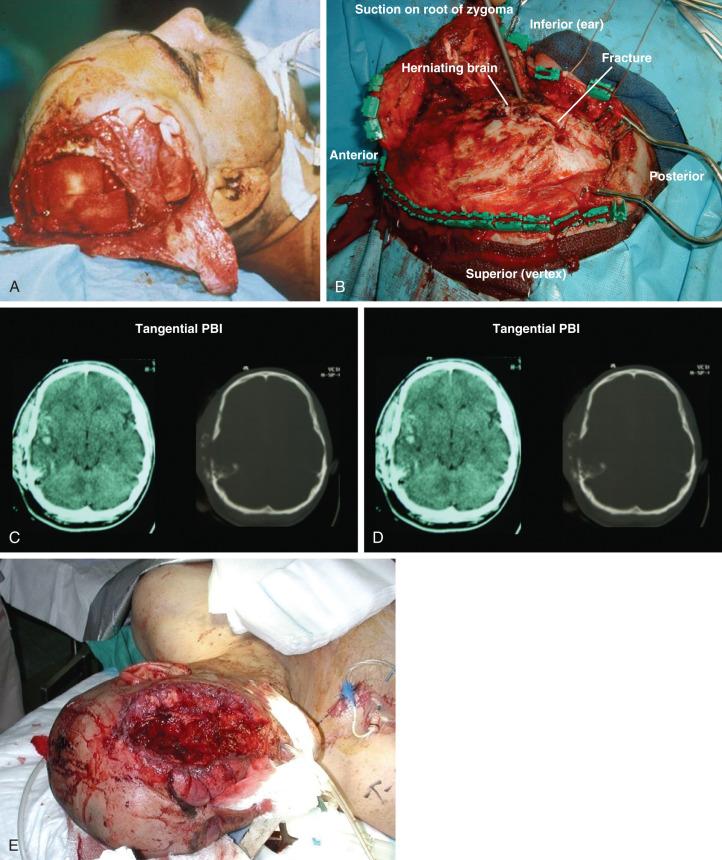
In 1995 the Brain Trauma Foundation developed the first traumatic brain injury (TBI) guidelines with the assistance of international experts in the field to address the need for protocol-driven health care based on the most current scientific literature. In 2001 guidelines for the care of PBI were created toward the same end with the support of the Brain Injury Association, the International Brain Injury Association, the American Association of Neurological Surgeons (AANS), and members of the Congress of Neurological Surgeons (CNS). These guidelines stand as the most comprehensive evidence-based evaluation of interventions specific to the care of PBI and are summarized in Table 27.2 . It is worth mentioning, however, that despite the exhaustive literature search used to develop the guidelines, no recommendation achieves a level beyond that of option, and this underscores the need for further research. The utilization of these guidelines across trauma centers in the United States has helped to establish better uniformity with the best standards of practice. In addition, more strategies in PBI management have been adopted from the military and applied to civilian patients.
| Topic | Conclusion | Recommendation Level |
|---|---|---|
| I. Antibiotic prophylaxis | The use of prophylactic broad-spectrum antibiotics is recommended for patients with PBI. | Option |
| II. Seizure prophylaxis | The use of prophylactic antiseizure medications in the first week after PBI is recommended to prevent early posttraumatic seizures. | Option |
| III. ICP monitoring | Early ICP monitoring is recommended when the clinician is unable to assess the neurologic examination accurately or if CT scans suggest elevated intracranial pressure. The need to evacuate a mass lesion is unclear. | Option |
| IV. Management of CSF leaks | Surgical correction is recommended for CSF leaks that do not close spontaneously or are refractory to temporary CSF diversion. During the primary surgery, every effort should be made to close the dura and prevent CSF leaks. | Option |
| V. Neuroimaging | CT scanning of the head is strongly recommended. Angiography is recommended in PBI when a vascular injury is suspected. Routine MRI is not recommended for use in the acute management of missile-induced PBI. | Option |
| VII. Surgical management | Evacuation of hematomas with mass effect, conservative débridement of missile tract without retrieval of remote fragments, débridement of nonviable scalp, bone, or dura before primary closure, and watertight repair of open-air sinus injuries is recommended. | Option |
| VIII. Vascular complications | CT angiography or conventional angiography should be considered when vascular injury is suspected. If traumatic intracranial aneurysm (TICA) or arteriovenous fistula (AVF) is identified, surgical or endovascular management is recommended. | Option |
Craniofacial injuries sustained during Operation Enduring Freedom (OEF) and Operation Iraqi Freedom (OIF) have resulted in further modifications to the surgical management of patients with severe PBI. Although aggressive débridement of the brain is no longer supported, early and aggressive cranial decompression with subsequent watertight dural closure of the dura and scalp through craniofacial techniques adopted from civilian practice is the current accepted practice during wartime ( Fig. 27.3 ). This strategy affords the patient protection from significant elevations in intracranial pressure (ICP) during air evacuation from combat theaters to the United States. This initial stabilization is then followed by protocol-driven neurocritical care aimed at preventing secondary neurologic sequelae and maximizing neurologic recovery. Though the data are still under review, preliminary analysis appears favorable for this treatment paradigm (see Fig. 27.3 ).

Civilian PBI has high mortality rates that remain refractory to medical and neurosurgical advances based on the most recent case series. The mortality rate in most retrospective cohorts is greater than 70% owing in large part to the higher percentage of gunshot wounds (see Fig. 27.3 ), suicides, and the ubiquitous absence of cranial protection (helmets) compared to military injuries. Other variables that differentiate these two groups are presented in Table 27.3 . The reported civilian mortality rates from gunshot wounds to the head (GSWH) in the literature range from 23% to 92%, with those series on the lower end including a number of cases without dural violation. Death from PBI occurs shortly after injury with 70% of patients succumbing after the first 24 hours ( Table 27.4 ).
| Factor | Civilian | Military |
|---|---|---|
| Population | Heterogeneous | Homogeneous (younger overall age) |
| Mechanism | Gunshot/suicide | Blast/shrapnel |
| Environment | Modern sanitation | Possibly contaminated |
| Prehospital care | Variable | Immediate |
| Tertiary care | Hours | Variable |
| Injury severity score (ISS) | Low | High |
| Topic | Conclusion | Data Class |
|---|---|---|
| I. Age | Age > 50 years is associated with higher rate of mortality, but significance is unclear. | III |
| II. Cause of injury (suicide) | Self-inflicted GSWH carry a higher rate of mortality than those for other causes. | II |
| III. Mode of injury | Perforating wounds have a higher mortality rate than tangential or penetrating PBIs. | III |
| IV. Caliber of weapon | No demonstrated effect. | |
| V. Hypotension | Hypotension is associated with increased mortality rate. | III |
| VII. Coagulopathy | Coagulopathy is associated with increased mortality rate. | III |
| VIII. Respiratory distress | Respiratory distress is associated with increased mortality rate. | III |
| IX. GCS | In civilian injuries, low GCS score correlates with higher mortality rate and unfavorable outcome. In military injuries, low GCS score correlates with unfavorable outcome. | I (civilian)III (military) |
| X. Pupil size and response | The presence of bilateral fixed and dilated pupils is highly predictive of fatal outcome. | III |
| XI. ICP | High ICP is predictive of higher mortality rate. | II |
Given the high degree of mortality with civilian PBI, it has become helpful to identify factors that may be used at initial presentation to better determine a patient's overall survivability and quality of life. Several prognostic indicators have been analyzed and studied in the literature. These are summarized in Table 27.4 . A postresuscitation Glasgow Coma Scale (GCS) score can be used as a reliable predictor of death and other unfavorable outcomes. This measure is a consistent predictor for both civilian and military populations but appears to have the greatest correlation with civilian mortality. In a series segregating out patients with poor presenting neurologic function, specifically those with GCS scores of 3 to 5, the mortality rate rises to 87% to 100%. Gressot and colleagues created a scoring system to determine mortality and the chance of having an overall good outcome. The factors involved include age, GCS score, and pupillary exam, along with the trajectory of injury. This scale is shown in Table 27.5 . It illustrates the improved overall survivability in addition to functional outcome based on trajectory of injury as well as age and neurologic exam. Such scales can be applied at the bedside to assist with an understanding of a patient's overall mortality or chance of a good outcome in order to determine how aggressively to intervene. A recommended triage scheme for both military and civilian patients is located in Fig. 27.4 .
| Scoring System | |
|---|---|
| Variable | Score |
| Age > 35 yrs | +1 |
| GCS Score 3 or 4 | +1 |
| Nonreactive pupils | +1 |
| Trajectory | |
| Posterior fossa or bihemispheric | +2 |
| Mortality and Functional Outcome | ||
|---|---|---|
| Score | Rate | |
| Mortality | 0–1 | 25% |
| 2 | 50% | |
| 3–5 | 75% | |
| Good Outcome | 0 | 50% |
| 1 | 30% | |
| 2 | 10% | |
| 3–5 | 0% | |
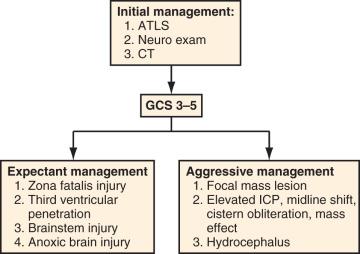
The many disparate characteristics between civilian and military populations have made it difficult to compare treatment strategies and prognostic features across these two groups. However, a study by Dubose and associates compared the epidemiology and outcomes of military and civilian severe TBI. The Joint Trauma Theater Registry (JTTR) military database and the civilian American College of Surgeons' National Trauma Data Bank (NTDB), both the largest patient databases of their kind, were queried for severe TBI and PBI. Subgroup analysis was then selected for isolated PBI and statistically matched counterparts across the same period of 2003 to 2006. The results showed a threefold increase toward neurosurgical intervention in the JTTR military group compared with the civilian group, particularly in the frequency of ICP monitoring (13.8% vs 1.7%). The civilian NTDB outcomes showed a tenfold increase in mortality rate when compared to the JTTR military population (47.9% vs 5.6%). Although a dramatic difference in mortality rates between these populations is not a revelation, this study excludes the confounding differences in explosive fragment PBI injuries and allows for a more direct comparison of military versus civilian missile wounds.
To make these populations truly comparable, however, the high rate of suicides and point-blank injuries in the civilian population needs to be accounted for in the analysis. In their case series of civilian GSWH, Hofbauer and colleagues analyzed the impact of shooting distance on mortality rate in contact, near contact, intermediate range, and at distance. Those at intermediate and long distances had a 0% mortality rate in the 19 patients treated. In contrast, the contact group showed mortality rates of 91% with self-inflicted wounds ( n = 46) and 100% with nonself-inflicted wounds ( n = 4). Until variables of mechanism and modes of injury can be more appropriately matched, treatment effects across civilian and military PBI will be difficult to compare ( Figs. 27.5 and 27.6 ).

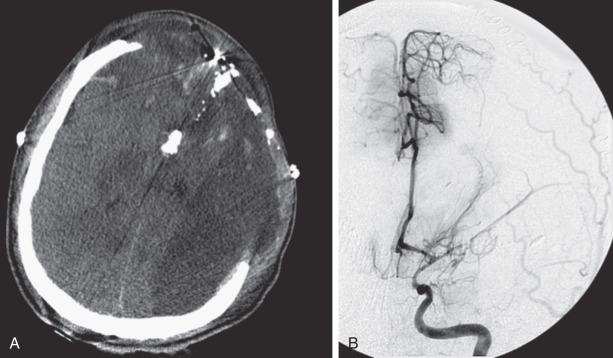
The pathophysiology of penetrating head injury is in many ways similar to other more common forms of severe TBI. Injury can be classified as either primary (directly resulting from the penetrating force) or secondary (injury sustained from complications of the initial penetrating injury). Initial neurologic cell death occurs immediately in and around the trajectory of the penetrating object (see Fig. 27.5 ). Subsequent or secondary cell death can occur as a result of increased ICP, mass effect from space-occupying lesions, stroke from vessel injury (see Fig. 27.6 ) or delayed ischemic neurologic deficits resulting from traumatic vasospasm ( Fig. 27.7 ), complications from infection, uncontrolled seizure activity, and delayed hydrocephalus. Surgical and critical care management strategies must therefore be directed at mitigating complications from the secondary neurologic injury described ( Fig. 27.8 ).
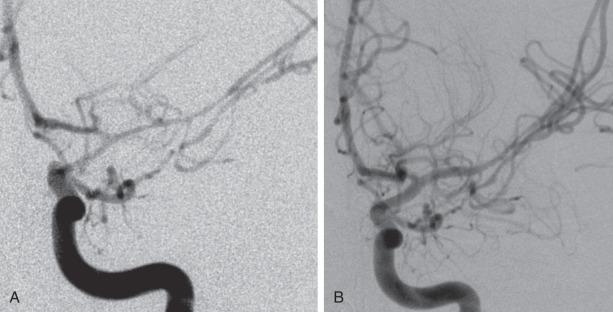
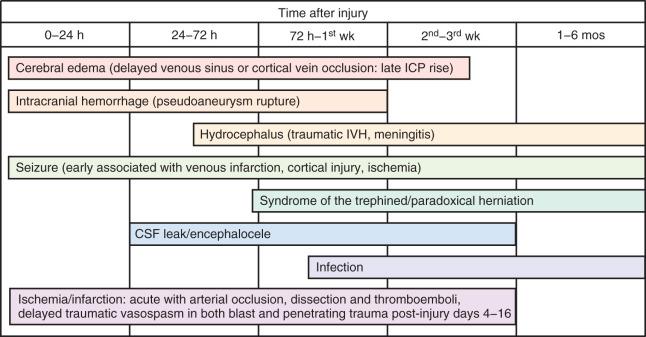
The disruption of the normal coagulation response to underlying brain injury is incompletely understood. We have, however, gained a greater understanding the hematologic issues associated with PBI as the mechanisms that underlie the bleeding coagulopathies are elucidated. The release of tissue factors has been implicated in activating the extrinsic pathway leading initially to a hypercoagulable state, which eventually is followed by a bleeding diathesis with consumption of clotting factors. Various other secondary messenger pathways are still being examined to better understand the mechanisms causing a coagulopathy in PBI.
Open PBI mechanisms have been described in various classification systems and include descriptive terms such as high velocity, low velocity, blunt, explosive, penetrating, and perforating. For the purpose of this chapter, anything related to gunshot wounds to the head will be explicitly defined. Penetrating fragment injuries will be referred to as explosive or blast fragmentation injuries. Blunt injuries will include open, comminuted, and depressed skull fractures with in-driven bone fragments as the result of a nonpenetrating external force (ie, “under the body armor”) ( Fig. 27.9 ). Discussion concerning nonprojectile penetrating injuries (ie, stab wound from knives or sticks) will be excluded in this chapter given the relative low incidence in the referenced studies. The most common cause of PBI shared between civilian and military populations are GSWH. The lethality of GSWH is greater than the majority of penetrating blast fragment injuries seen during combat and has been assumed to be partially responsible for the less favorable outcomes in the civilian population. The ratio of fragment to GSWH in combat, approximately 7 : 2, remains relatively consistent among wartime conflicts in the literature.
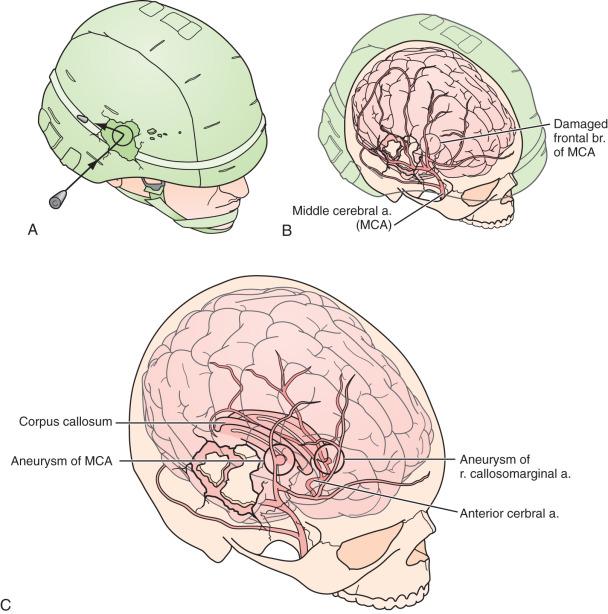
Ballistics, or the study of the dynamic properties of a projectile, is useful when reconstructing the events at time zero of the impact. Terminal or wounding ballistics is perhaps even more relevant to the neurosurgeon, as it describes how the projectile behaves after impacting tissue. Kinetic energy (KE), also known as wounding energy, is the quantity of energy that a projectile transfers to the brain and creates damage. Kinetic energy is calculated by the equation KE = (Mass) (Velocity), revealing the relative weight that velocity conveys to a missile's wounding potential.
In low-velocity wounds, the injury is caused primarily by the projectile itself, crushing tissue within its immediate trajectory and creating a permanent cavity. High-velocity wounds, in contrast, create a more complex pattern of injury based on the whether the projectile penetrates or perforates the cranial vault and the degree of the KE imparted to the tissue. The KE of a perforating wound can be calculated as equal to (Mass) (Impact velocity − Exit velocity). The release of KE into tissue causes a phenomenon of cavitation: a brief, compressive force that expands tangentially from the tract of primary injury, generating a destructive wake. After the KE is depleted and the cavity has expanded to its maximal size, the area begins to collapse under negative pressure and may suck in surrounding debris. The cavity may then subsequently undergo further expansions and contractions in decreasing amplitudes depending on the viscoelastic properties of the tissue. In inelastic tissue, such as brain, the permanent cavity can become tenfold larger than the diameter or profile of the offending projectile.
Other characteristics of a projectile include caliber, shape, yaw, precession and nutation, and ballistic coefficient. A round's caliber is defined by the internal diameter of the weapon's barrel, therefore representing the widest diameter of the bullet. This can be measured in both inches (0.45) and millimeters (9 mm) and essentially approximates the bullet's mass. The shape of a projectile may be sharp or round nosed, or it may be completely spherical as is the case in some explosive munitions. The shape will be the main determinant of the other following characteristics. Yaw is the rotation of a bullet around its long axis. As the yaw of a projectile increases to 90 degrees, the size of the permanent cavity, and therefore tissue destruction, is maximized. The potentially large discrepancy between in-flight yaw and tissue-travel yaw explains why an exit wound may be many times larger than the entry wound. The precession and nutation are the circular motions of a projectile in flight and contribute more to in-flight stability than impact damage. The ballistic coefficient, or drag, is the force that resists a bullet's forward velocity. This, along with initial velocity, will determine the effective range of the weapon. Other factors that contribute to tissue destruction include fragmentation and explosive potential, ricochet ( Fig. 27.10 ), jacketed or unjacketed rounds, and hollow-nosed or soft-pointed cartridges.
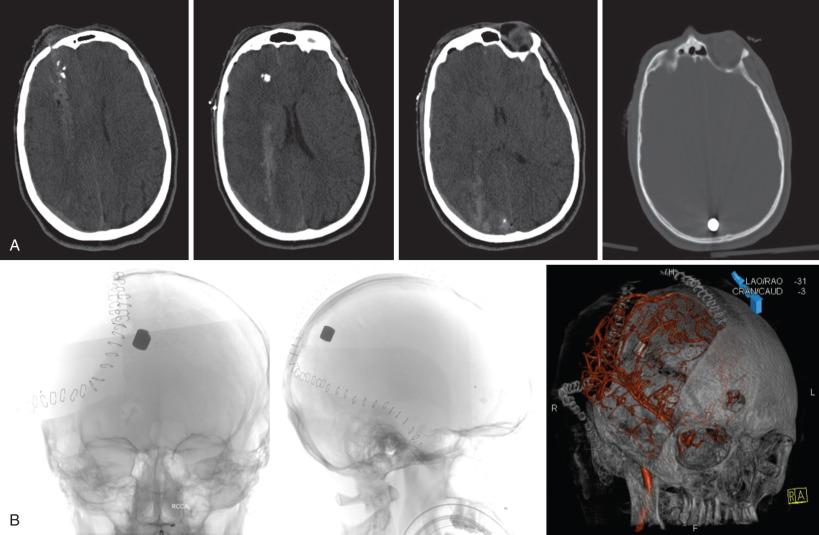
Become a Clinical Tree membership for Full access and enjoy Unlimited articles
If you are a member. Log in here